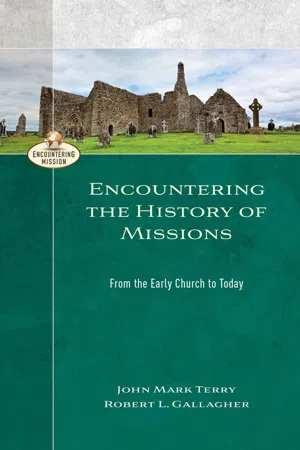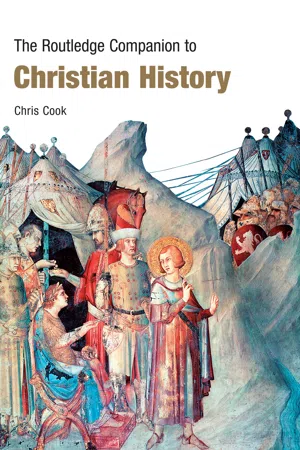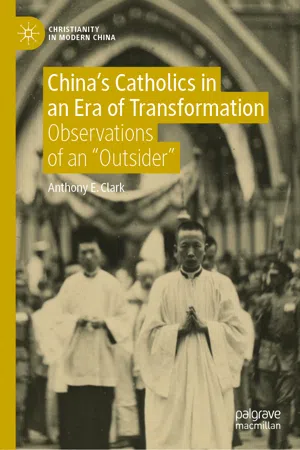Catholic Missionaries in China
Catholic missionaries in China refers to the efforts of Catholic Church members to spread Christianity in China, particularly during the Ming and Qing dynasties. Jesuit missionaries played a significant role in this endeavor, introducing Western science and technology to the Chinese court. The interactions between Catholic missionaries and Chinese culture had a lasting impact on both religious and intellectual developments in China.
6 Key excerpts on "Catholic Missionaries in China"
- Arthur Lin(Author)
- 2020(Publication Date)
- Pickwick Publications(Publisher)
...Early on, Jesuits worked in the cities seeking to Christianize Chinese society from the top down. However, the later ban on Christianity resulted in most missionaries leaving and Chinese Catholics hiding in remote countryside villages. When China reopened to the missionaries, they largely worked in villages with existing Chinese Catholics. In the early 1900 s, some progressive Catholic thinkers insisted that the hope of the Church in China depended on reaching the educated in the cities. However, when Maryknollers arrived in China, most missionaries maintained that the hope of the Church was in the rural areas where over 80 percent of the population lived. 222 It is noteworthy to mention French Catholic motives for missions, especially before the twentieth century. While they are to be commended for arriving first, it is also apparent, at least at times, that they came with mixed motives. Jean-Paul Wiest, former project coordinator of the Maryknoll China History Project, wrote, “Astute leaders of state and monarchs saw overseas missions as an effective means to further their national and colonial ambitions.” 223 Rome launched a “civilizing mission” in 1838, an initiative with clear links to colonialism. The mission assumed the superiority of European culture and sought to civilize and Christianize people perceived as backward. In an article called “Catholic Mission Theory and Practice,” Wiest summed up the French motives: [China] was seen as a backward, pagan country under the influence of evil. . .. To evangelize non-Christian China, the MEP 224 [Paris Mission Society] used French government support to establish their mission in the provinces of Guangdong and Guangxi...
- eBook - ePub
Catholic Missionaries in Early Modern Asia
Patterns of Localization
- Nadine Amsler, Andreea Badea, Bernard Heyberger, Christian Windler, Nadine Amsler, Andreea Badea, Bernard Heyberger, Christian Windler(Authors)
- 2019(Publication Date)
- Routledge(Publisher)
...Introduction Localizing Catholic missions in Asia Nadine Amsler, Andreea Badea, Bernard Heyberger, and Christian Windler Since the sixteenth century, the narratives of mission history have been shaped by the Catholic Church’s claims to universality and have been connected with the history of European expansion. It was at that time that the Latin term missio gained its double meaning of spreading faith among non-Christians and intensifying faith among Christians. 1 The missions became a central motif in the self-fashioning of the papacy, religious orders, and secular Catholic rulers, as they facilitated a demarcation from the churches that emerged from the Protestant Reformation, which were less active in this field. 2 Members of religious orders wrote the histories of the missions of their communities, in order to legitimate their claims to a well-respected position within church and society. The Jesuits were especially successful in this, but less well-known orders, such as the Discalced Carmelites, also tried to emulate their example. 3 The varying levels of self-promotion of missionary orders make their effects felt even today in the one-sided focus of research on the Jesuits. However, it has been research on this very order, which has fundamentally changed our view of the Catholic missions in recent times. During the last decades, scholars have increasingly read the mission orders’ self-representations against the grain and started to question their universalist-expansionist framework. As a result, the trajectory of the history of religious missions has moved away from the Eurocentric history of religious orders, and toward broader questions of cultural history. These questions are facilitating a renewal of the research on the Catholic missions of the early modern period, which, in turn, offers stimulating impulses for the investigation of intercultural communication. 4 Research on early modern Catholic missions in China has been a case in point...
- eBook - ePub
Encountering the History of Missions (Encountering Mission)
From the Early Church to Today
- Terry, John Mark, Gallagher, Robert L., Moreau, A. Scott(Authors)
- 2017(Publication Date)
- Baker Academic(Publisher)
...This reprisal against the Catholic Church originated from the new emperor’s prophetic concern for the ambitious political role of the papacy in his country. The following conversation between the emperor and a Jesuit priest demonstrates this anxiety. What would you say if I sent a troop of Bonzes and Lamas into your country to preach their doctrines? You want all Chinese to become Christians. Your law demands it, I know. But in that case, what will become of us? Shall we become subjects of your king? The converts you make recognize only you in time of trouble. They will listen to no other voice but yours. I know that at the present time, there is nothing to fear, but when your ships come by thousands, then there will probably be great disorder. (Boxer 1991, 46) Finally, in 1742, Pope Benedict XIV gave all Catholic missionaries an order: agree to abide by the prohibition of rites. The tensions that resulted from the clash between the Qing dynasty and the Vatican proved detrimental to the growth of the church in China for over two hundred years. Not until 1939 did Pope Pius XII finally revoke the papal restrictions on Chinese Catholics (Loewe 1988, 207). Missions Results in China What was the Jesuit influence in China? The order’s interpretation of Christianity gained them access among many of the Confucian literati and other higher-class groups. This continued missionary access to the emperor, and their role as official scholars aided in increasing the impact of Christianity on the educated classes. Concerned for the christianization of China, Ricci commented, “We desired to build something solid, so that converts would answer to the name of Christian, and in these beginnings, spread the good odor of our faith” (Dunne 1962, 105). As they assimilated with the academic class that governed the country, the Jesuits were so successful in bringing about a Confucian-Christian synthesis that other Catholic orders, following them to China, accused them of syncretism...
- Derek Davis, Elena Miroshnikova, Derek Davis, Elena Miroshnikova(Authors)
- 2013(Publication Date)
- Routledge(Publisher)
...The three traditional Chinese religions—Daoism, Buddhism, and Confucianism—are indigenous religions. Islam, Protestantism, and Catholicism are imported religions. Strictly speaking, Confucianism and Daoism are typical Chinese indigenous religions, although many Western scholars do not regard Confucianism as religion. Since Buddhism came into China in the first century from India, it has merged in every aspect of Chinese society. Thus, China’s religious heritage is made up of three religious traditions, the so-called san jiao. 1 In imperial China, Buddhist and Daoist temples only provided very limited religious education within their own circles owing to financial restrictions, and formal Buddhist and Daoist schools did not exist. Christian missionary activity in China began in the seventh century. Nestorian Alopen, the first Christian missionary, arrived in Xian in 635 during the Tang dynasty. The second wave of the Christian mission was the Roman Catholic missionary movement. John Corvino, the first Catholic missionary and a zealous Franciscan monk, arrived in China in 1292 under the Yuan dynasty, 2 but the Catholic mission did not have much influence on China until Matteo Ricci arrived there in the sixteenth century. 3 After thefirst Opium War, both Catholicism and Protestantism began to develop relatively rapidly in China. Accordingly, religious education, particularly Christian education, emerged, especially in the east-coast cities, such as Shanghai, Nanjing, Fujian, and Guandong. However, owing to the resistance from Chinese indigenous religious movements, religious education was mainly limited to the religious schools which were established by foreign missionaries. After the Nationalist government was finally settled in Nanjing in 1927, Chinese Christianity gained more ground. The growth of the Chinese Christian movement slowed down again after the C.P.C. came to power in 1949...
- eBook - ePub
- Chris Cook(Author)
- 2020(Publication Date)
- Routledge(Publisher)
...THE MISSIONARIES AND THE FAR EAST CHINA Early missions (to 1727) 635 Mission from independent Nestorian Church of Persia of senior priest Araben to China. Mission based at Chang’an (now Xi’an). Chapels constructed and preaching undertaken. During later reign of Wu Zong, Christianity banned alongside Buddhism. Christianity extinct in inland China. 1245–53 Two missions of Franciscan Friars reach Mongol capital Qaraqorum (in present-day Mongolia). 1312 Catholic Franciscan friars despatched by Pope Nicholas IV and dioceses created (1312). 1333 Death of Giovanni de Monte Corvino, Archbishop of Peking. Note: After the fall of the Yuan dynasty, Christianity again became extinct until the sixteenth century Jesuit missions. Sixteenth–seventeenth century Jesuit missions begin to penetrate China at end of Ming dynasty. These included MatteoRicci (1552–1610), Julio Aleni (1551– 1649), and, later, Jean François Gerbillon (1654–1707). 1715 Condemnation of the ‘Chinese rites’ (i.e. emphasis on ancestor worship) in the bull Ex illa die. 1717 Missions to China banned by edict of Kang-Hsi. 1727 Russo-China Treaty followed by despatch of official Orthodox missionaries from Russia. The modern era 1773 Suppression of activities of Society of Jesus. 1785 Persecution of Christians. 1800s Growing attempts at trade with China and introduction of Protestant churches. 1805–11 Renewed period of persecution (in Beijing). 1807 Arrival of London Missionary Society and Robert Morrison (1782–1834) at Canton. 1830 First missionaries of ABC. 1834 Jesuits began work in China. 1839–42 Opium War. Hong Kong acquired by Britain. 1857–58 Taiping Rebellion (major uprising against imperial government). 1865 Formation of the very influential interdenominational China Inland Mission by J. Hudson Taylor (1832–1905)...
- eBook - ePub
China's Catholics in an Era of Transformation
Observations of an "Outsider"
- Anthony E. Clark(Author)
- 2020(Publication Date)
- Palgrave Macmillan(Publisher)
...Sino-Christian exchange has at some level influenced the overall history of China since the appearance of Franciscan mendicants during the Yuan dynasty, but Catholics were certainly not the only participants in China’s early modern and modern transformation. Secular diplomats and Protestant missionaries, too, were lively interlocutors within the Sino-Western dialogue. The English explorer and naturalist, Thomas Wright Blakiston (1832–1891), serves as a good example of a non-Catholic Westerner who participated in Sino-Western exchange in China. Blakiston made his way of the Yangze River in 1861, and when he encountered the Catholic missionaries around Wuhan, he believed a “disguised priest or two of the Romish Church” had surreptitiously concealed themselves within the Chinese population. 10 As William T. Rowe puts it, “Roman Catholic missionaries were not the only Europeans who made their presence felt in Hankow [district of Wuhan ] in pre-treaty-port days.” 11 The cultural connections between Westerners and Chinese during the nineteenth, twentieth, and twenty-first centuries are ubiquitous and complex; these essays represent only a small portion of intellectual and religious encounters between East Asia and the West. Cultural dialectics are never homogenous, and I trust that this volume supports that assertion. To make one final point: while the word “conflict” has appeared throughout these essays, I do not suggest that conflict has monolithically defined Sino-Western encounters. Far from it. Just as often the word “friendship” appears throughout this compendium, and this is a much better term to describe the general nature of China’s long relationship with the West. Beatrice Leung and William T...





